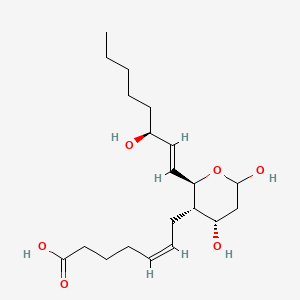| MeSH term | MeSH ID | Detail |
|---|---|---|
| Hemolysis | D006461 | 131 associated lipids |
| Airway Obstruction | D000402 | 13 associated lipids |
| Uremia | D014511 | 33 associated lipids |
| Stomach Ulcer | D013276 | 75 associated lipids |
| Kidney Failure, Chronic | D007676 | 51 associated lipids |
| Diabetes Mellitus | D003920 | 90 associated lipids |
| Hypoxia | D000860 | 23 associated lipids |
| Graft Occlusion, Vascular | D006083 | 11 associated lipids |
| Arrhythmias, Cardiac | D001145 | 42 associated lipids |
| Adenocarcinoma | D000230 | 166 associated lipids |
Thromboxane b2
Thromboxane b2 is a lipid of Fatty Acyls (FA) class. Thromboxane b2 is associated with abnormalities such as endothelial dysfunction, Diabetes Mellitus, Non-Insulin-Dependent, Diabetes Mellitus, Ischemia and Thrombocytosis. The involved functions are known as Platelet Activation, Excretory function, Anabolism, Inflammation and mRNA Expression. Thromboxane b2 often locates in Endothelium, Hepatic and Microsomes, Liver. The associated genes with Thromboxane b2 are PTGS2 gene, prothrombin fragment 2 and CCL14 wt Allele.
Cross Reference
Introduction
To understand associated biological information of Thromboxane b2, we collected biological information of abnormalities, associated pathways, cellular/molecular locations, biological functions, related genes/proteins, lipids and common seen animal/experimental models with organized paragraphs from literatures.
What diseases are associated with Thromboxane b2?
Thromboxane b2 is suspected in endothelial dysfunction, Diabetes Mellitus, Non-Insulin-Dependent, Diabetes Mellitus, Ischemia, Thrombocytosis, Acute Coronary Syndrome and other diseases in descending order of the highest number of associated sentences.
Related references are mostly published in these journals:
| Disease | Cross reference | Weighted score | Related literature |
|---|
Possible diseases from mapped MeSH terms on references
We collected disease MeSH terms mapped to the references associated with Thromboxane b2
PubChem Associated disorders and diseases
What pathways are associated with Thromboxane b2
There are no associated biomedical information in the current reference collection.
PubChem Biomolecular Interactions and Pathways
Link to PubChem Biomolecular Interactions and PathwaysWhat cellular locations are associated with Thromboxane b2?
Visualization in cellular structure
Associated locations are in red color. Not associated locations are in black.
Related references are published most in these journals:
| Location | Cross reference | Weighted score | Related literatures |
|---|
What functions are associated with Thromboxane b2?
Related references are published most in these journals:
| Function | Cross reference | Weighted score | Related literatures |
|---|
What lipids are associated with Thromboxane b2?
There are no associated biomedical information in the current reference collection.
What genes are associated with Thromboxane b2?
Related references are published most in these journals:
| Gene | Cross reference | Weighted score | Related literatures |
|---|
What common seen animal models are associated with Thromboxane b2?
There are no associated biomedical information in the current reference collection.
NCBI Entrez Crosslinks
All references with Thromboxane b2
Download all related citations| Authors | Title | Published | Journal | PubMed Link |
|---|---|---|---|---|
| Hu MK et al. | Synthesis and evaluation of backbone/amide-modified analogs of leualacin. | 1999 | Bioorg. Med. Chem. Lett. | pmid:10098664 |
| Takami M and Tsukada W | Effects of DP-1904, a thromboxane synthetase inhibitor, on the antigen-induced airway hyperresponsiveness and infiltration of inflammatory cells in guinea-pigs. | 1998 | Prostaglandins Leukot. Essent. Fatty Acids | pmid:10102387 |
| Stenach N et al. | The effects of heparin bound surface modification (Carmeda Bioactive Surface) on human platelet alterations during simulated extracorporeal circulation. | 1992 | J Extra Corpor Technol | pmid:10148074 |
| Mitchell MD et al. | Production of thromboxane B2 by the intra-uterine tissues from late pregnant Rhesus monkeys (Macaca mulatta) in vitro. | 1978 | J. Endocrinol. | pmid:101641 |
| Mayer AM et al. | Escherichia coli lipopolysaccharide potentiation and inhibition of rat neonatal microglia superoxide anion generation: correlation with prior lactic dehydrogenase, nitric oxide, tumor necrosis factor-alpha, thromboxane B2, and metalloprotease release. | 1999 | Shock | pmid:10188770 |
| Kay-Mugford T and Conlon P | Possible inconsistencies in study on cyclooxygenase. | 1999 | Am. J. Vet. Res. | pmid:10188806 |
| Yamamoto T et al. | Production of prostanoids and nitric oxide by infarcted heart in situ and the effect of aspirin. | 1999 | Biochem. Biophys. Res. Commun. | pmid:10198239 |
| Nelson DM et al. | Hypoxia limits differentiation and up-regulates expression and activity of prostaglandin H synthase 2 in cultured trophoblast from term human placenta. | 1999 | Am. J. Obstet. Gynecol. | pmid:10203658 |
| Chakraborti T et al. | Age-dependent change in arachidonic acid metabolic capacity in rat alveolar macrophages. | 1999 | Biochem. Mol. Biol. Int. | pmid:10204087 |
| Catella-Lawson F et al. | Effects of specific inhibition of cyclooxygenase-2 on sodium balance, hemodynamics, and vasoactive eicosanoids. | 1999 | J. Pharmacol. Exp. Ther. | pmid:10215647 |
